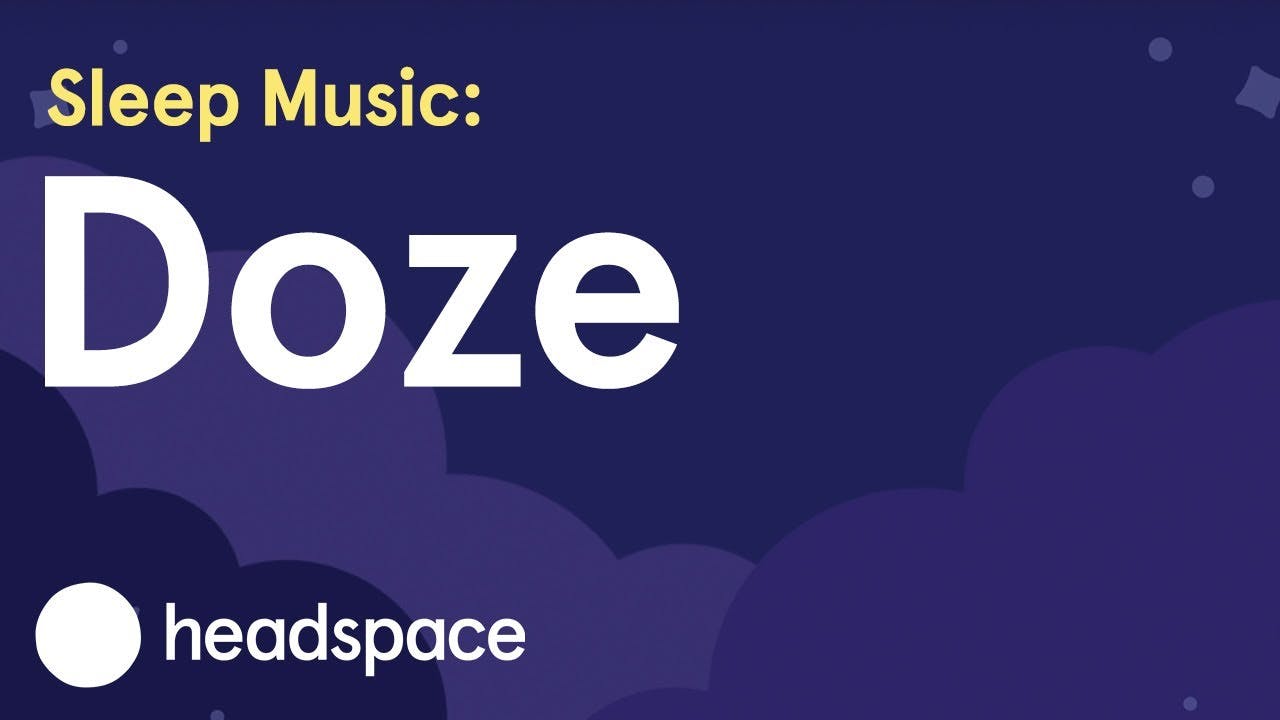How to fall back asleep
By Your Headspace Mindfulness & Meditation Experts
Mar 18, 2021
Here we are in the dark at 3 am with eyes wide open, struggling to fall back asleep. Anyone who’s experienced significant bouts of sleeplessness knows the havoc this can wreak on our energy, mood, and cognition. To help, we’ve pulled together the best tips on how to fall back asleep.
Ready to get better sleep?
Start your free trial
Relax your body, calm your mind, and drift off
Ease back into a restful night’s sleep with these deep, ambient sounds.

Sleep Music: Doze
45 mins
Waking up in the middle of the night — or in the middle of a sleep cycle — and being unable to fall back asleep may be a common sleep disorder. If you’re experiencing this, you’ll first want to schedule a trip to the doctor to make sure there are no underlying medical issues behind those sleepless nights.
Assuming you get the all-clear from your doc, your sleeplessness may be caused by worry, stress, and/or poor sleep hygiene habits that you may wish to improve.
Is stress making it difficult to fall back asleep?
Stress often kicks in due to a situation we can see and comprehend; we tend to know what we are dealing with and what is stressing us out. While it’s not always possible to control everything that is happening to us or around us, it is possible to change the way we relate to those things that are happening. Softening the way we perceive stress and relating to it in a more accepting way is the first trick for how to deal with stressful feelings — like the ones that might be keeping you up at night.
One scientifically proven way to relieve stress is meditation. In one study, Headspace was found to reduce stress by 11% in just 10 days, while 30 days of Headspace reduced stress in participants by a third.
Rather than being caught up in our thoughts, practicing meditation for stress teaches us to become the observers of certain mental patterns and, therefore, become less physically affected by them. In training the mind to be more open and less reactive, we are better able to cope when life’s stressors, day or night.
Feeling stressed?
Try a meditation to rest a busy mind and find a greater sense of peace.
Falling back asleep
The common theme that tends to run through all the things that make us feel stressed in life is a busy mind. Thankfully, there are practical ways to put your mind to bed when thoughts are racing.
Here are 8 tips to help you go back to sleep
1. Don’t look at the clock.
When you get tired of staring at the ceiling or switching sleep positions, it’s tempting to take a peek at the time. Resist the urge to check the clock. Sleep experts agree that watching the minutes pass sets off a worry cycle, keeping your brain more alert and stressing you out. It makes getting back to sleep that much harder. If you’ve got a clock on your night table, turn it around (your phone shouldn’t be anywhere nearby).
2. Try a relaxation exercise.
There are several different types to choose from. Harneet Walia, MD, a physician at the Cleveland Clinic's Sleep Disorders Center, suggests progressive muscle relaxation, a meditation-based technique. Starting with your toes and working up to your forehead, tightly tense each of your muscles for five seconds, and then slowly let them relax. Do one leg and one arm at a time, and pay special attention to areas of your body that hold tension, like your jaw and neck.
Integrative health specialist Dr. Andrew Weil recommends a 4-7-8 breathing exercise, which he says serves as a “natural tranquilizer” for the nervous system, helping to ease you back to sleep. The goal is to slow down your breathing, which forces the rhythm of your heart to slow as well, relaxing the body and mind. To start, place the tip of your tongue against the ridge of tissue behind your upper front teeth for the exercise. Then:
- Completely exhale through your mouth, making a whoosh sound
- Keeping your mouth closed, inhale through your nose for 4 counts
- Hold your breath for a count of 7
- Exhale completely through your mouth for a count of 8
- Repeat this process 3 more times for a total count of 4 breath cycles
If the counting and holding are too complicated, any type of deep, slow breathing can have a calming effect and help you fall back asleep. One simple way to do this is to lie in your bed on your back, legs extended, and arms at your side. Imagine your lungs are balloons, and take the deepest breath you can, filling the balloons, then exhale completely, deflating the balloons. Repeat this as many times as needed/as is comfortable.
3. Distract your busy mind with a visualization technique.
The more you try to make yourself fall back to sleep, the more elusive sleep will be. So, think about something else. Whether you’re counting livestock or picturing yourself on a beautiful island beach, the idea is the same, according to Eric J. Olson, MD, sleep medicine specialist at the Mayo Clinic. "You're getting your mind off of 'I can't sleep; I can't sleep; I can't sleep,' and onto something else." Any type of visualization or repetition — counting your breaths, even reciting poems you remember from childhood — can lull your brain into relaxation, and help you go back to sleep.
4. Drift off to a sleepcast.
Sleepcasts from Sleep by Headspace(available only to Headspace subscribers) are designed for the same purpose as a visuilzation, only a narrator does the work of creating the distraction for you. To help you drift off, soothing voices guide you through dreamy environments like Desert Campfire, Downriver, and Night Town, among others. They’re remixed each night to create a visualization experience that's different each time — so you can’t memorize how far along you are but it still feels familiar.
5. Put your worries on paper.
Often, sleeplessness stems from worry. At 2 am, without any daytime distractions, our minds can easily shift into overdrive. Many sleep experts recommend keeping a pen and pad on your night table or by your bed so you can commit your worries to paper. No matter what you’re obsessing over, rather than ruminating, write it down. This takes the commotion out of your head so you can let it go, clearing your mind. Just make sure to keep the lights dim (or use a flashlight or nightlight) when jotting down notes, as bright light can disrupt your body clock.
6. Listen to music.
You don’t need scientific studies to tell you that listening to music can quiet your mind and help you relax, but here it is anyway. Research shows that music can have a direct effect on the parasympathetic nervous system, encouraging your body to relax and prepare for sleep. It can slow your heart rate and breathing, lower your blood pressure, and even relax muscles — the biological changes you experience when you're falling asleep.
So which type is best? Music, of course, is a personal preference, and you're most likely to relax listening to something you know and enjoy. Findings suggest that music with 60 to 80 beats per minute (60 BPM being the low end of a healthy resting heart rate) does the trick, and classical music is ideal. Jazz and folk songs are also good.
Sleep music from Sleep by Headspace (available only to Headspace subscribers) is designed specifically to be a soundtrack for falling asleep. Headspace's sleep music helps establish a soothing baseline of sound without too much variation, to help you fall asleep — and keep you asleep. One generalized 2017 study (that did not use Headspace) found that “natural sounds” help promote relaxation by positively affecting the autonomic nervous system. The great news is that recorded sounds and music can have just the same effect.
Once you integrate music into your bedtime routine, stick with it. The positive sleep effects can build over time, as listening to your relaxing sleep soundtrack becomes a habit that cues your body to prepare for zzzzzs.
7. Meditate to help fall back asleep.
Meditation helps to increase the prospect of getting you back to sleep by igniting the parasympathetic nervous system, lowering the heart rate, and encouraging slow breathing. Just putting aside 10 minutes to do a simple breathing meditation before bed can help you get off to sleep quicker because it creates a buffer between your waking life and your bedtime.
If you’re having trouble falling back to sleep, try meditating in bed, lying flat on your back with your head on the pillow. Or start a Headspace wind-down exercise for sleep, and take a few deep breaths, relax your body, and close your eyes.
When we try meditation or a wind-down exercise with sleep in mind, it’s important to relax and take some deep breaths to release any tension. And then, as you exhale, feel the weight of your body sinking down into the mattress, feeling the contact between your body and the bed — from the heels of your feet to the back of your head. Allow the mind to drift off in its own time, letting thoughts go, and maintaining a relaxed focus on the natural rhythm of the breath. Anytime a thought pops into your head, simply return to the breath to anchor you in the land of Nod.
8. Try getting out of bed.
Many sleep specialists recommend getting out of bed after about 15 or 20 sleepless minutes (your best guesstimate, since you’re not looking at the clock, remember?). The more you lie in bed feeling frustrated, the more your brain associates the bedroom with not sleeping well, and the more you’ll come to anticipate sleeplessness the next time you’re there. Go to another room and try something relaxing, like listening to music or reading. A warm bath or shower may also help, as the change in body temperature before going back to a cool room should help get you drowsy.

Stay in the loop
Be the first to get updates on our latest content, special offers, and new features.

A final thought on falling back asleep
One thing sleep doctors agree on: falling asleep should be effortless, and trying too hard can backfire. One specialist, Dr. Dev Banerjee, recalls asking a patient what he did to fall back asleep, “The guy said, ‘I say to myself, I must fall asleep, I must fall asleep!’” And of course, the result was the opposite. “So I suggested that he repeats silently to himself, ‘I must stay awake, I must stay awake.’ He tried it, and it actually worked.”


Sleep made simple
- Find your perfect bedtime routine with hours of relaxing music, sounds, and stories to choose from
- Get more restful sleep with our Sleep Health course: exercises developed with leading sleep scientists
- Feel your best from morning to bedtime with access to hundreds of stress-relieving meditations


Stay in the loop
Be the first to get updates on our latest content, special offers, and new features.
By signing up, you’re agreeing to receive marketing emails from Headspace. You can unsubscribe at any time. For more details, check out our Privacy Policy.
- © 2025 Headspace Inc.
- Terms & conditions
- Privacy policy
- Consumer Health Data
- Your privacy choices
- CA Privacy Notice







